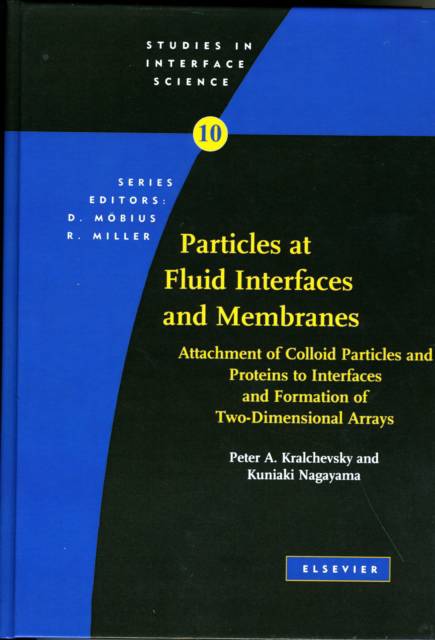
- Afhalen na 1 uur in een winkel met voorraad
- Gratis thuislevering in België vanaf € 30
- Ruim aanbod met 7 miljoen producten
- Afhalen na 1 uur in een winkel met voorraad
- Gratis thuislevering in België vanaf € 30
- Ruim aanbod met 7 miljoen producten
Zoeken
Particles at Fluid Interfaces and Membranes
Attachment of Colloid Particles and Proteins to Interfaces and Formation of Two-Dimensional Arrays Volume 10
€ 321,45
+ 642 punten
Omschrijving
In the small world of micrometer to nanometer scale many natural and industrial processes include attachment of colloid particles (solid spheres, liquid droplets, gas bubbles or protein macromolecules) to fluid interfaces and their confinement in liquid films. This may lead to the appearance of lateral interactions between particles at interfaces, or between inclusions in phospholipid membranes, followed eventually by the formation of two-dimensional ordered arrays. The book is devoted to the description of such processes, their consecutive stages, and to the investigation of the underlying physico-chemical mechanisms. The first six chapters give a concise but informative introduction to the basic knowledge in surface and colloid science, which includes both traditional concepts and some recent results. Chapters 1 and 2 are devoted to the basic theory of capillarity, kinetics of surfactant adsorption, shapes of axisymmetric fluid interfaces, contact angles and line tension. Chapters 3 and 4 present a generalization of the theory of capillarity to the case, in which the variation of the interfacial (membrane) curvature contributes to the total energy of the system. The generalized Laplace equation is applied to determine the configurations of free and adherent biological cells. Chapters 5 and 6 are focused on the role of thin liquid films and hydrodynamic factors in the attachment of solid and fluid particles to an interface. Surface forces of various physical nature are presented and their relative importance is discussed. Hydrodynamic interactions of a colloidal particle with an interface (or another particle) are also considered.Chapters 7 to 10 are devoted to the theoretical foundation of various kinds of capillary forces. When two particles are attached to the same interface (membrane), capillary interactions, mediated by the interface or membrane, appear between them. Two major kinds of capillary interactions are described: (i) capillary immersion force related to the surface wettability (Chapter 7), (ii) capillary flotation force originating from interfacial deformations due to particle weight (Chapter 8). Special attention is paid to the theory of capillary immersion forces between particles entrapped in spherical liquid films (Chapter 9). A generalization of the theory of immersion forces allows one to describe membrane-mediated interactions between protein inclusions into a lipid bilayer (Chapter 10).Chapter 11 is devoted to the theory of the capillary bridges and the capillary-bridge forces, whose importance has been recognized in phenomena like consolidation of granules and soils, wetting of powders, capillary condensation, long-range hydrophobic attraction, etc. The nucleation of capillary bridges is also examined.Chapter 12 considers solid particles, which have an irregular wetting perimeter upon attachment to a fluid interface. The undulated contact line induces interfacial deformations, which engender a special lateral capillary force between the particles. The latter contributes to the dilatational and shear elastic moduli of particulate adsorption monolayers.Chapter 13 describes how lateral capillary forces, facilitated by convective flows and some specific and non-specific interactions, can lead to the aggregation and ordering of various particles at fluid interfaces or in thin liquid films. Recent results on fabricating two-dimensional (2D) arrays from micrometer and sub-micrometer latex particles, as well as 2D crystals from proteins and protein complexes, are reviewed. Chapter 14 presents applied aspects of the particle-surface interaction in antifoaming and defoaming. The mechanisms of antifoaming action involve as a necessary step the entering of an antifoam particle at the air-water interface. The considered mechanisms indicate the factors for control of foaminess.
Specificaties
Betrokkenen
- Uitgeverij:
Inhoud
- Aantal bladzijden:
- 668
- Taal:
- Engels
- Reeks:
- Reeksnummer:
- nr. 10
Eigenschappen
- Productcode (EAN):
- 9780444502346
- Verschijningsdatum:
- 22/01/2001
- Uitvoering:
- Hardcover
- Formaat:
- Genaaid
- Afmetingen:
- 159 mm x 241 mm
- Gewicht:
- 1369 g

Alleen bij Standaard Boekhandel
+ 642 punten op je klantenkaart van Standaard Boekhandel
Beoordelingen
We publiceren alleen reviews die voldoen aan de voorwaarden voor reviews. Bekijk onze voorwaarden voor reviews.










